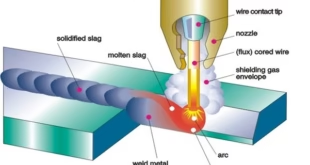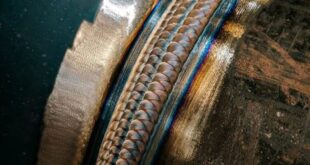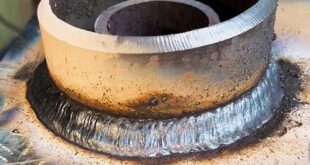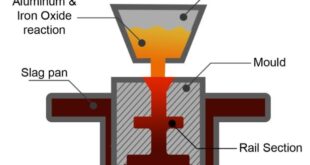Diffusion welding is a joining process that involves the bonding of two or more materials through the diffusion of atoms across the joint interface. It is a solid-state welding technique that does not require the melting of the base materials. Instead, it relies on high temperature and pressure to facilitate atomic diffusion between the mating surfaces.
Diffusion welding is an important process in various industries, including aerospace, automotive, energy, and manufacturing. It offers several advantages over other welding methods, such as minimal distortion, no filler material requirement, and the ability to join dissimilar materials. The resulting joints exhibit high strength, excellent integrity, and often match or exceed the mechanical properties of the base materials.
The applications of diffusion welding are diverse and widespread. In aerospace, it is utilized for joining turbine blades, rocket engine components, and aircraft structures. In the automotive industry, diffusion welding finds applications in the fabrication of exhaust systems, fuel cells, and engine components. It is also employed in power generation systems, such as in the production of heat exchangers and nuclear fuel elements. Additionally, diffusion welding is used for manufacturing high-performance components, such as super-alloy parts for gas turbines and heat-resistant alloys for petrochemical plants.
The importance of diffusion welding lies in its ability to create strong, durable, and reliable joints between different materials, even those with significant differences in properties. By enabling the joining of dissimilar materials, diffusion welding expands the possibilities for engineering design and allows the utilization of advanced materials in various applications. Furthermore, it provides a cost-effective and efficient alternative to traditional welding methods, particularly when dealing with complex geometries or delicate structures.
Basic Principles of Diffusion Welding
Diffusion welding operates on the basic principles of diffusion bonding, where two or more materials are joined through atomic diffusion at the interface. This process occurs in the solid state, without the need for melting the base materials. Instead, it relies on elevated temperatures and pressure to facilitate the diffusion of atoms across the joint.
Several key factors influence the success and quality of diffusion welding:
- Temperature: Temperature plays a critical role in diffusion welding as it determines the diffusion rate of atoms. Sufficiently high temperatures are required to enable atomic movement across the joint interface. The temperature must be carefully controlled to ensure optimal diffusion while avoiding excessive grain growth or material degradation.
- Pressure: Pressure is applied during diffusion welding to ensure intimate contact between the mating surfaces. It aids in improving atomic diffusion by eliminating voids or gaps. The applied pressure should be sufficient to promote intimate contact and facilitate atomic movement without causing deformation or damage to the materials.
- Time: The duration of the diffusion welding process, often referred to as the hold or dwell time, is an important parameter. Sufficient time is needed for atomic diffusion to occur and create a strong bond between the materials. The hold time is typically determined based on the materials being joined and their diffusion characteristics.
- Surface preparation: Proper surface preparation is crucial for successful diffusion welding. The mating surfaces must be cleaned thoroughly to remove contaminants, oxides, and impurities that could hinder diffusion. Surface roughening techniques, such as grinding or etching, may be employed to increase the contact area and enhance the bonding strength. Additionally, the use of interlayers or coatings can aid in promoting atomic diffusion and mitigating material incompatibilities.

Diffusion Welding Techniques
Diffusion welding encompasses different techniques, each with its own characteristics and applications:
Solid-state diffusion welding
Solid-state diffusion welding is a technique where the mating surfaces are brought into intimate contact and subjected to high temperature and pressure without reaching the melting point of the base materials. The process steps typically involve:
- Surface preparation: The mating surfaces are thoroughly cleaned to remove contaminants and oxides that could hinder diffusion.
- Assembly: The materials are aligned and pressed together under high pressure to establish intimate contact.
- Heating: The assembly is heated to an elevated temperature below the melting point of the materials. This temperature enables atomic diffusion across the interface.
- Dwell time: The assembly is held at the elevated temperature for a specified duration to allow sufficient diffusion to occur.
- Cooling: The assembly is gradually cooled down under pressure to solidify the diffusion bond.
Advantages of solid-state diffusion welding include the ability to join dissimilar materials with varying melting points and thermal properties. It also provides precise control over the joint geometry and does not introduce any filler material. However, it requires relatively high temperatures and long dwell times, limiting its applicability to certain materials and situations.
Liquid-state diffusion welding
Liquid-state diffusion welding involves the introduction of a liquid phase between the mating surfaces to facilitate atomic diffusion. The process steps are as follows:
- Surface preparation: The mating surfaces are cleaned and prepared as in solid-state diffusion welding.
- Assembly: A thin layer of a suitable interlayer material or filler metal is placed between the mating surfaces.
- Heating: The assembly is heated to a temperature that allows the interlayer or filler metal to melt and form a liquid phase.
- Dwell time: The assembly is held at the elevated temperature to enable diffusion of atoms between the liquid and base materials.
- Cooling: The assembly is cooled down, and the liquid phase solidifies, forming a diffusion bond.
Liquid-state diffusion welding offers advantages such as lower process temperatures, shorter dwell times, and improved joint formation. It allows for greater control over the diffusion process and offers versatility in joining materials with large differences in melting points. However, it requires careful selection of interlayer materials and may introduce residual stresses and porosity in the joint.
Hybrid diffusion welding
Hybrid diffusion welding combines elements of both solid-state and liquid-state diffusion welding techniques. It involves the use of an interlayer material that partially melts and promotes atomic diffusion. The process steps typically include:
- Surface preparation: The mating surfaces are cleaned and prepared as in other diffusion welding methods.
- Assembly: An interlayer material is placed between the mating surfaces.
- Heating: The assembly is heated to a temperature that allows partial melting of the interlayer material while keeping the base materials in the solid state.
- Dwell time: The assembly is held at the elevated temperature to enable atomic diffusion between the interlayer and base materials.
- Cooling: The assembly is cooled down to solidify the joint and form a diffusion bond.
Hybrid diffusion welding combines the advantages of both solid-state and liquid-state techniques, providing improved control over the diffusion process while maintaining lower process temperatures. It offers flexibility in joining dissimilar materials and can mitigate some of the limitations associated with the other two techniques.
Each diffusion welding technique has its own advantages and limitations, making them suitable for different applications and material combinations. The selection of the appropriate technique depends on factors such as material compatibility, joint requirements, and process conditions.
Surface Preparation for Diffusion Welding
Surface preparation is a critical step in diffusion welding to ensure proper bonding between the mating surfaces. The surface must be clean, free from contaminants, and optimized for atomic diffusion. The surface preparation for diffusion welding typically involves the following steps:
Cleaning and degreasing
Before joining, the mating surfaces need to be thoroughly cleaned and degreased to remove any dirt, oil, or grease that could hinder diffusion or compromise the quality of the bond. Common cleaning methods include solvent cleaning, ultrasonic cleaning, and acid etching. This process ensures that the surfaces are free from impurities and promote effective atomic diffusion.
Surface roughening and activation
Surface roughening techniques are often employed to increase the contact area between the mating surfaces, enhancing the bond strength and promoting atomic diffusion. Mechanical methods like grinding, sandblasting, or shot peening can be used to create a textured surface. Additionally, surface activation treatments such as plasma cleaning or laser ablation can be applied to further improve the surface reactivity and promote interatomic bonding.
Interlayer application and selection
An interlayer material is used between the mating surfaces to facilitate diffusion bonding. The interlayer material acts as a diffusion medium and helps promote atomic movement between the base materials. The selection of the interlayer material depends on the specific materials being joined and their compatibility. Common interlayer materials include metallic foils, powders, or thin coatings. The interlayer material should have a melting temperature lower than the base materials to ensure proper bonding without causing excessive melting or deformation.
The interlayer thickness is also an important consideration, as it affects the diffusion pathway and the strength of the resulting bond. It should be chosen based on the desired joint properties and the specific application requirements.
Proper surface preparation for diffusion welding is crucial to achieve strong and reliable joints. By cleaning and degreasing the surfaces, roughening them to increase contact area, and applying suitable interlayer materials, the diffusion welding process can be optimized to promote atomic diffusion and create high-quality bonds between the materials.
Factors Affecting Diffusion Weld Quality
Temperature and heating rate
The temperature at which diffusion welding is performed has a significant impact on the quality of the weld joint. The temperature must be carefully controlled to ensure optimal atomic diffusion without causing excessive grain growth, material degradation, or undesired phase transformations. Additionally, the heating rate, or the rate at which the temperature is increased, affects the microstructure and the resulting mechanical properties of the joint. Proper control of temperature and heating rate is crucial for achieving a defect-free and high-strength diffusion weld.
Pressure and applied force
Pressure plays a vital role in diffusion welding by ensuring intimate contact between the mating surfaces. The applied force should be sufficient to establish and maintain contact throughout the welding process, allowing atomic diffusion to occur. Adequate pressure helps eliminate voids, gaps, or surface contaminants, which can hinder the diffusion process and compromise the weld quality. However, excessive pressure can lead to deformation or damage to the materials. The optimal pressure and applied force must be determined based on the specific materials being joined and the desired joint properties.
Material compatibility and selection
The compatibility of the materials being joined is critical for successful diffusion welding. Materials with similar crystal structures, atomic sizes, and diffusion rates tend to exhibit better compatibility and enhanced diffusion bonding. However, when joining dissimilar materials, special consideration must be given to their compatibility, including differences in thermal expansion coefficients, melting points, and chemical reactivity. Incompatible materials can lead to the formation of brittle intermetallic compounds, poor diffusion, or even joint failure. Therefore, careful material selection and compatibility assessment are essential for achieving high-quality diffusion welds.
Joint design and geometry
The design and geometry of the joint significantly influence the diffusion welding process and the resulting weld quality. Factors such as joint clearance, mating surface area, and alignment of the mating surfaces play a crucial role. A proper joint design ensures sufficient contact area for atomic diffusion, uniform distribution of pressure and force, and minimizes stress concentrations. Additionally, the geometry of the joint, including the thickness and shape of the materials being joined, can impact the diffusion process, thermal distribution, and mechanical properties of the joint. Therefore, careful consideration of joint design and geometry is necessary to achieve desired diffusion weld quality.
By considering and optimizing these factors, diffusion welding can produce high-quality weld joints with excellent integrity and mechanical properties.
Advantages and Applications of Diffusion Welding
Advantages of diffusion welding
Diffusion welding offers several advantages compared to other conventional joining processes:
- Strong and reliable joints: Diffusion welding produces joints with high strength and integrity. The atomic diffusion between the mating surfaces leads to a metallurgical bond, resulting in a joint that often matches or exceeds the mechanical properties of the base materials.
- Joining of dissimilar materials: Diffusion welding enables the joining of dissimilar materials, including combinations of metals, alloys, and even ceramics. It allows for the utilization of advanced materials with different properties, expanding design possibilities and enhancing performance in various applications.
- Minimal distortion and no filler material requirement: Since diffusion welding is a solid-state process, there is minimal distortion or deformation of the materials being joined. It does not require the use of filler materials, simplifying the welding process and avoiding potential issues associated with filler compatibility or distortions caused by mismatched thermal expansion coefficients.
- Compatibility with complex geometries: Diffusion welding can accommodate complex geometries and intricate shapes. It can be applied to join components with intricate features, such as turbine blades, rocket engine parts, or other complex structures, where other conventional welding methods may be challenging or impractical.
Applications in various industries
Diffusion welding finds extensive applications in numerous industries, including:
- Aerospace: Diffusion welding is widely used in aerospace applications, such as joining turbine blades, airframe structures, rocket engine components, and aircraft exhaust systems. It allows for the creation of strong and durable joints in critical components, ensuring reliable performance under extreme operating conditions.
- Automotive: In the automotive industry, diffusion welding is employed in the fabrication of exhaust systems, engine components, and fuel cells. It enables the joining of dissimilar materials, contributes to weight reduction, and enhances overall vehicle performance and efficiency.
- Energy: Diffusion welding plays a vital role in energy-related applications. It is used in the production of heat exchangers, nuclear fuel elements, and components for power generation systems, such as gas turbines and steam turbines. Diffusion welding ensures efficient heat transfer and reliable operation of energy systems.
- Manufacturing: Diffusion welding is utilized in various manufacturing sectors, including the production of high-performance components. It is applied in the fabrication of superalloy parts for gas turbines, heat-resistant alloys for petrochemical plants, and other specialized components that require superior strength, corrosion resistance, and reliability.
Challenges and Future Developments
Current challenges in diffusion welding
Despite its advantages, diffusion welding still faces certain challenges that researchers and industry professionals are actively addressing
- Process optimization: Diffusion welding processes often require precise control of temperature, pressure, and dwell time. Achieving optimal process parameters for different material combinations and joint configurations can be challenging and time-consuming.
- Material limitations: While diffusion welding can join a wide range of materials, certain material combinations may pose challenges due to differences in melting points, thermal properties, or reactivity. Developing suitable interlayers or surface modification techniques to overcome these limitations is an ongoing challenge.
- Quality control and non-destructive evaluation: Ensuring the integrity of diffusion welds and detecting potential defects or flaws non-destructively is crucial. Developing reliable inspection techniques to detect defects, such as voids, cracks, or interfacial delaminations, is an ongoing area of research.
Recent advancements and research areas
Recent advancements and ongoing research efforts are focused on addressing the challenges and expanding the capabilities of diffusion welding:
- Process modeling and simulation: Advanced computational modeling and simulation techniques are being used to better understand the complex diffusion phenomena during welding. These models aid in optimizing process parameters, predicting joint quality, and reducing the need for extensive experimental trials.
- Advanced interlayer materials: Researchers are exploring the use of new interlayer materials, including nanomaterials, metallic glasses, and tailored intermetallic compounds, to enhance bonding and improve joint strength. These advanced interlayers enable joining of previously incompatible materials and offer improved mechanical and functional properties.
- Additive manufacturing and diffusion bonding: The integration of additive manufacturing techniques with diffusion bonding opens up new possibilities for fabricating complex, high-performance components. By selectively depositing materials and utilizing diffusion bonding for final consolidation, the strength and functionality of the manufactured parts can be enhanced.
Potential future developments and improvements
Looking ahead, several potential future developments can be anticipated in the field of diffusion welding:
- In-situ monitoring and control: The development of real-time monitoring techniques, such as optical sensing, acoustic emissions, or thermal imaging, can enable better control and feedback during the diffusion welding process. This would enhance process reliability, reduce defects, and improve joint quality.
- Joining of advanced materials: With the growing demand for advanced materials, such as composites, ceramics, and high-temperature alloys, further advancements in diffusion welding techniques are needed to join these materials effectively. Research efforts will focus on developing interlayer materials and surface modification techniques to enable the successful bonding of these advanced materials.
- Micro and nano-scale diffusion welding: As the demand for miniaturization and microfabrication increases, there is a need for diffusion welding techniques that can be applied at micro and nano scales. Developing specialized processes and equipment to achieve diffusion bonding at these small scales will open up new opportunities in microelectronics, biomedical devices, and other emerging fields.
FAQs
What is the application of diffusion welding process?
The application of diffusion welding process is wide-ranging and includes industries such as aerospace, automotive, energy, and manufacturing. It is used to join materials like metals, alloys, and ceramics, enabling the creation of strong and reliable joints in critical components.
What is the process of diffusion bonding?
The process of diffusion bonding, also known as diffusion welding, involves joining two materials by applying heat and pressure. During bonding, atomic diffusion occurs at the interface of the materials, leading to the formation of a metallurgical bond without the use of filler materials.
What are the types of diffusion welding?
The types of diffusion welding include solid-state diffusion welding, liquid-state diffusion welding, and hybrid diffusion welding. Solid-state diffusion welding involves applying heat and pressure without melting the base materials, while liquid-state diffusion welding involves partial melting of the materials. Hybrid diffusion welding combines elements of both solid-state and liquid-state techniques.
What is the difference between cold and diffusion welding?
The difference between cold welding and diffusion welding lies in the temperature at which the joining occurs. Cold welding refers to the bonding of materials at room temperature, typically achieved by applying pressure without the need for heat. Diffusion welding, on the other hand, involves the application of heat and pressure to facilitate atomic diffusion and bonding.
What is diffusion process?
The diffusion process refers to the movement of atoms or molecules from an area of high concentration to an area of low concentration. In the context of diffusion welding, it refers to the atomic diffusion that occurs between the mating surfaces during the welding process, leading to the formation of a strong bond.
What is called diffusion process?
The term “diffusion process” is a general term that can refer to any process involving the movement of atoms or molecules from a region of high concentration to a region of low concentration. In the context of diffusion welding, it specifically refers to the atomic diffusion that enables the bonding of materials.
What are the advantages of diffusion bonding?
The advantages of diffusion bonding include the formation of strong and reliable joints, the ability to join dissimilar materials, minimal distortion of the materials, and the absence of filler materials. It also allows for the joining of complex geometries and offers high joint integrity and mechanical properties.
Why is it called cold welding?
Cold welding is called so because it involves the bonding of materials at room temperature without the need for external heat. The process relies solely on the application of pressure, causing the atoms on the mating surfaces to come into intimate contact and bond at the atomic level, resulting in a solid-state joint.
Conclusion
Throughout this discussion, we have explored the diffusion welding process, its basic principles, techniques, and factors that affect its quality. We highlighted the importance of surface preparation, including cleaning, surface roughening, and interlayer selection. Additionally, we discussed the advantages of diffusion welding over other joining processes, its applications in industries such as aerospace, automotive, and energy, and the challenges it currently faces. Finally, we explored recent advancements, ongoing research areas, and potential future developments in diffusion welding.
Diffusion welding holds great importance and potential in numerous industries. Its ability to produce strong and reliable joints, join dissimilar materials, and accommodate complex geometries makes it a valuable joining process. In aerospace, automotive, energy, and manufacturing industries, diffusion welding offers opportunities for enhanced performance, improved efficiency, and the utilization of advanced materials. By addressing current challenges and embracing future developments, diffusion welding can further contribute to the advancement of these industries.
As diffusion welding continues to evolve, it is poised to overcome current challenges and expand its capabilities. Ongoing research in process optimization, advanced interlayer materials, and quality control will drive improvements in joint quality and reliability. Integration with additive manufacturing techniques and advancements in micro and nano-scale diffusion welding will open up new possibilities in diverse fields. With its unique advantages and potential for innovation, diffusion welding is set to play a vital role in the future of joining technologies.
 Welding of Welders All about Welding and Welders
Welding of Welders All about Welding and Welders



